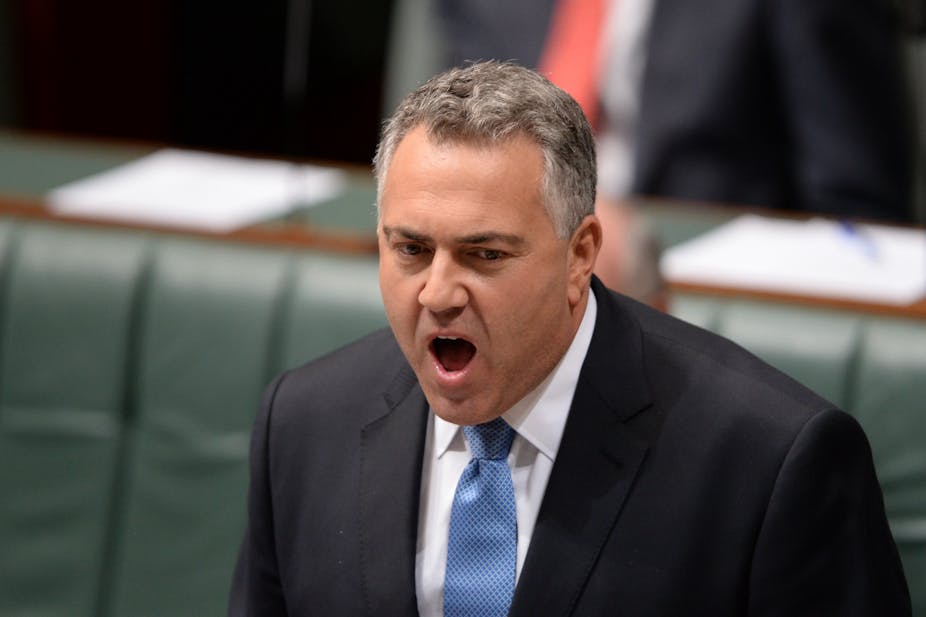The 2014-15 federal budget continues the deconstruction of Australia’s post-war welfare state. In fact, the budget takes it a step further, particularly for the young. People under the age of 30 will now have a quite different relationship to the social protection system. Essentially, their rights and entitlements to payments are heavily circumscribed. There are certainly no “entitlements”, as treasurer Joe Hockey promised.
Young people must now wait until they are 25 before they are eligible for a Newstart unemployment payment, and instead rely on the much lower Youth Allowance if under 25.
For those under the age of 30, there is a waiting period of six months before a claim for any assistance can be made, although some account will be taken of previous workforce experience. In addition, all payments are subject to “earn or learn” requirements.
The fallacies of ‘work for the dole’
In 1987, as a research officer at the Brotherhood of St Laurence, I wrote a policy paper entitled Community Work for Unemployed Young People. The paper argued against the Hawke government’s controversial proposal that unemployed young people should “work for the dole”.
The paper took the line that work for the dole was antithetical to the objectives enshrined in the post-war welfare state in which unemployment payments were an unconditional compensation for unemployment and, as such, a right. If you were unemployed you received a low but adequate payment while you looked for work until you found a job – no more, no less.
Of course, in the full employment post-war era, it didn’t take long to find a job. Your unemployment was a fault of the system in not providing jobs, so your unemployment payment was an entitlement. This was how welfare systems were constructed following the Great Depression and World War Two.
Work for the dole largely abandons these principles. It enshrines a view that unemployment is a matter of individual deficits. In this world view, there is no “entitlement” to compensation payments – especially if you are young with no or limited work experience. In fact, you must “work” for that payment.
Needless to say, my paper had no impact whatsoever and work for the dole has long been a part of the social welfare settings for unemployed young people. Perhaps there are some positive aspects to it, although the evidence for this is not strong.
According to economist Jeff Borland’s research, the best path out of unemployment for young people consists of jobs that emanate from economic growth. But high quality, flexible, locally driven labour market programs can also help.
Damaging the safety net
These new requirements attached to eligibility, as announced in the budget, profoundly damage the welfare state and certainly erode most of the original principles enshrined by its architects in the post-war period. Australian social protection is now seriously compromised.
The waiting period, denying unemployment payments, means that those waiting have no income. If they have been working in a low-paid and/or casual job, as many young people do, they will have little or no back-up savings if they lose a job. If they have emerged unemployed out of education and training, again they will have no income.

This is a very troubling dimension of the changes: there is, in effect, no social safety net. For some, a return to the family home and parental support may be an option but it won’t be for many. These people will be penniless and pauperised. It will put them at risk of homelessness and could also encourage greater participation in black or grey economies. This is certainly a very regressive element of the changes.
Young people, however, are not the only ones taking a king hit in this budget. The other group consists of older Australians, who will be working until they are 70 before qualifying for an age pension. The policy affects everyone born after 1958 and continues the present timeframe for increasing the pension eligibility age to 67 by 2024.
Many older people will struggle to maintain workforce participation until they are 70 and will be forced on to the lower Newstart unemployment payment if they have insufficient savings. This is most likely to be those who have worked in lower paid jobs through their working lives or who have had disrupted careers.
Compromising our future
It is also greatly troubling that policies that once were confined to the very young – those under the age of 21 – are now applicable to people up to the age of 30. There might be some justification for differential treatment for people under the age of 21 on account of their youth and lack of skills and experience. But there is no justification for treating people in their 20s up to the age of 30 as different citizens from older age groups.
People in their 20s are largely independent or wish to be so, are active social contributors, and many have their own families. They are on the path to becoming the leaders and key social actors of the future.
However, the policies instituted in Tuesday’s budget serve to infantilise, disempower and disenfranchise this group. The impact will consist of lower levels of social protection at key junctures during Australians’ lives, particularly at early and later stages – when such protection is most needed.

